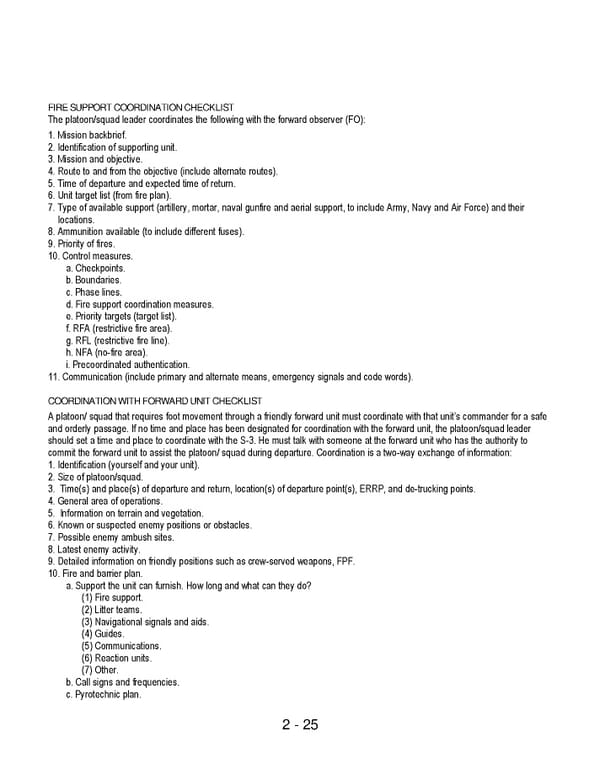2 - 25 FIRE SUPPORT COORDINATION CHECKLIST The platoon/squad leader coordinates the following with the forward observer (FO): 1. Mission backbrief. 2. Identification of supporting unit. 3. Mission and objective. 4. Route to and from the objective (include alternate routes). 5. Time of departure and expected time of return. 6. Unit target list (from fire plan). 7. Type of available support (artillery, mortar, naval gunfire and aerial support, to include Army, Navy and Air Force) and their locations. 8. Ammunition available (to include different fuses). 9. Priority of fires. 10. Control measures. a. Checkpoints. b. Boundaries. c. Phase lines. d. Fire support coordination measures. e. Priority targets (target list). f. RFA (restrictive fire area). g. RFL (restrictive fire line). h. NFA (no-fire area). i. Precoordinated authentication. 11. Communication (include primary and alternate means, emergency signals and code words). COORDINATION WITH FORWARD UNIT CHECKLIST A platoon/ squad that requires foot movement through a friendly forward unit must coordinate with that unit’s commander for a safe and orderly passage. If no time and place has been designated for coordination with the forward unit, the platoon/squad leader should set a time and place to coordinate with the S-3. He must talk with someone at the forward unit who has the authority to commit the forward unit to assist the platoon/ squad during departure. Coordination is a two-way exchange of information: 1. Identification (yourself and your unit). 2. Size of platoon/squad. 3. Time(s) and place(s) of departure and return, location(s) of departure point(s), ERRP, and de-trucking points. 4. General area of operations. 5. Information on terrain and vegetation. 6. Known or suspected enemy positions or obstacles. 7. Possible enemy ambush sites. 8. Latest enemy activity. 9. Detailed information on friendly positions such as crew-served weapons, FPF. 10. Fire and barrier plan. a. Support the unit can furnish. How long and what can they do? (1) Fire support. (2) Litter teams. (3) Navigational signals and aids. (4) Guides. (5) Communications. (6) Reaction units. (7) Other. b. Call signs and frequencies. c. Pyrotechnic plan.
 Ranger Handbook Page 46 Page 48
Ranger Handbook Page 46 Page 48